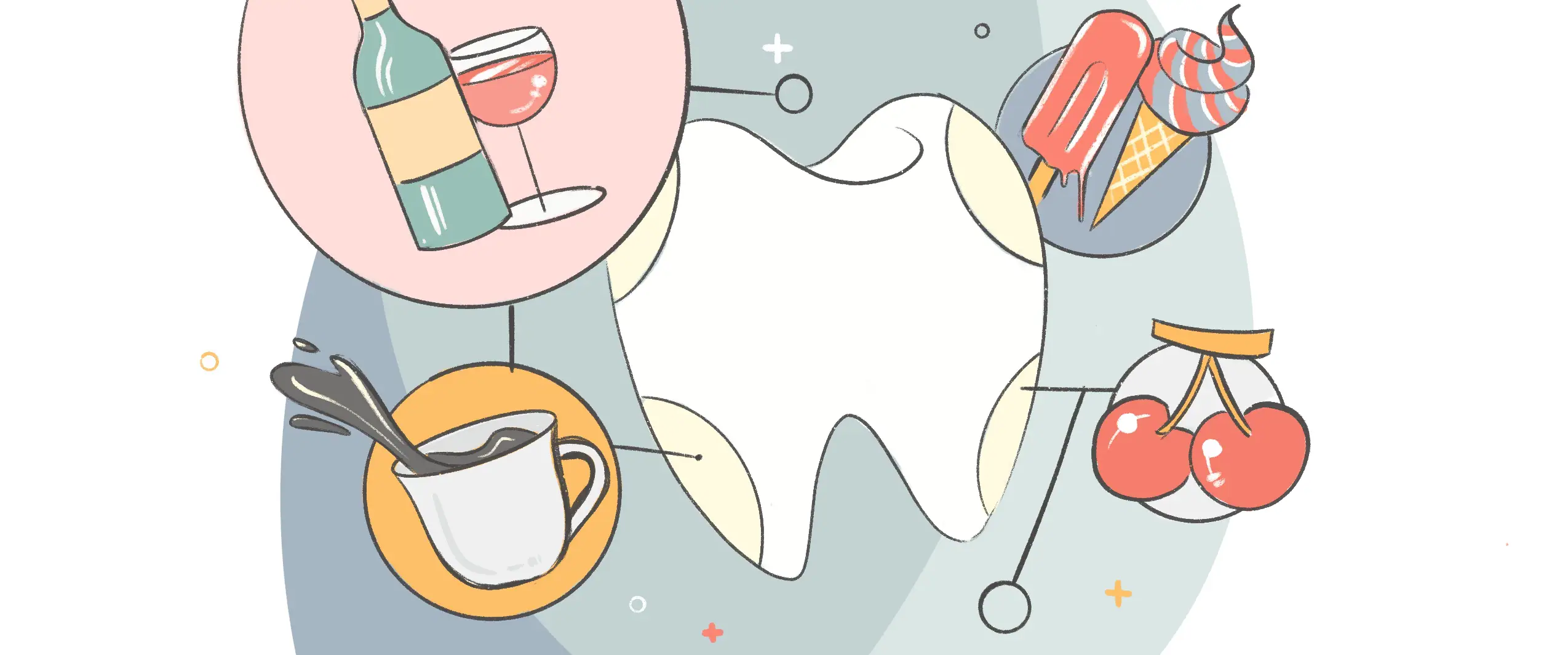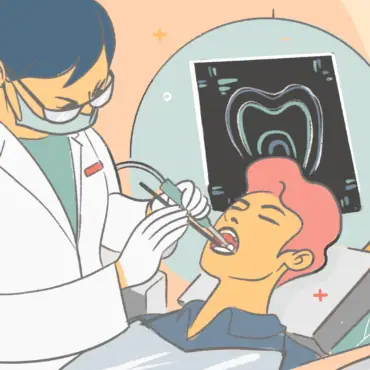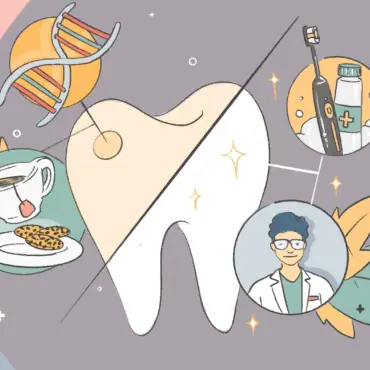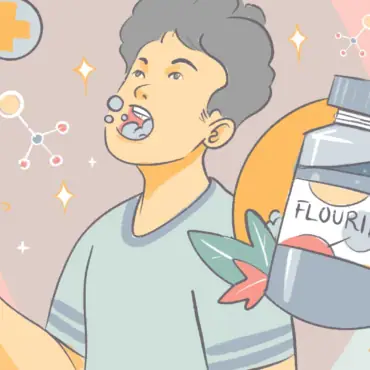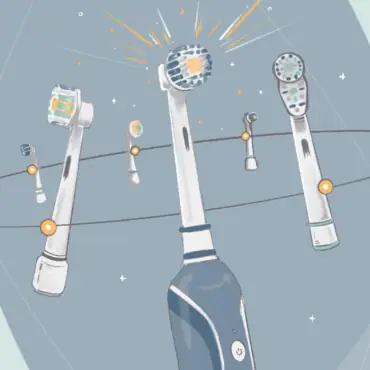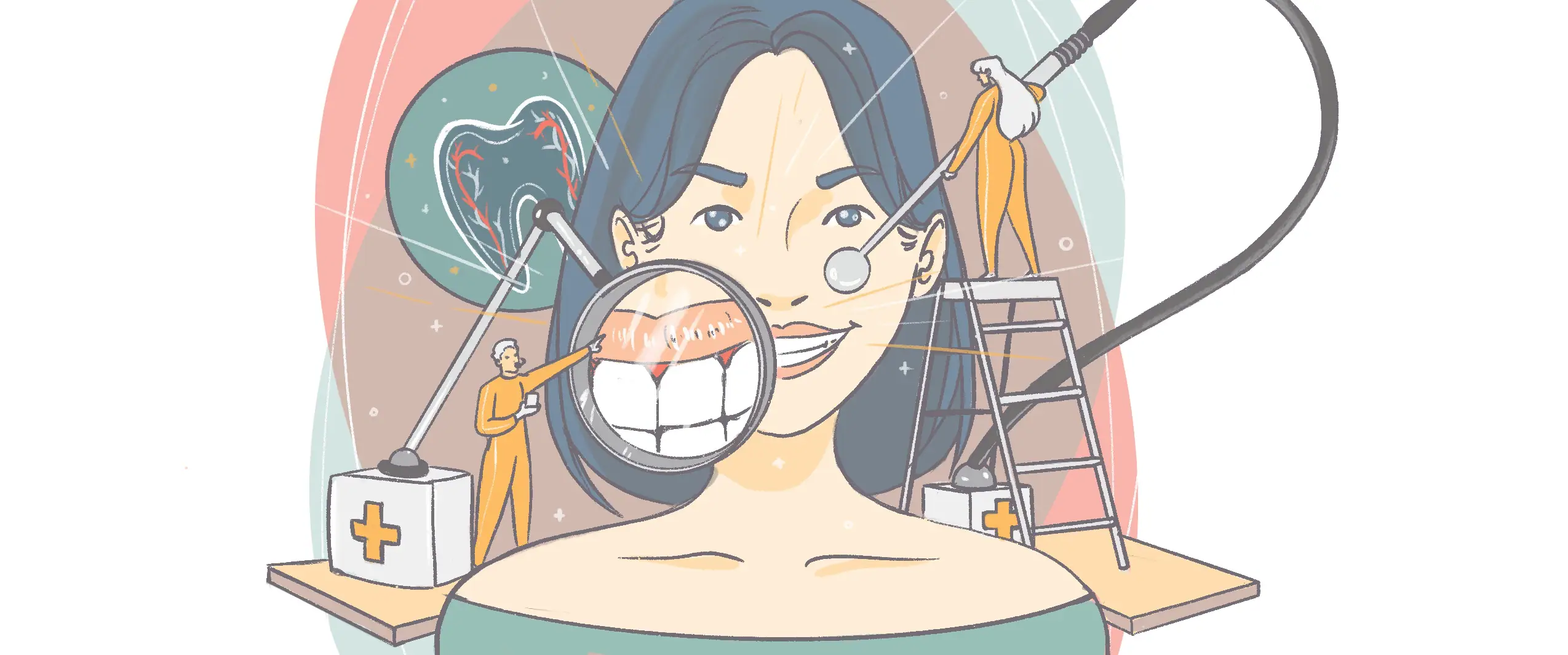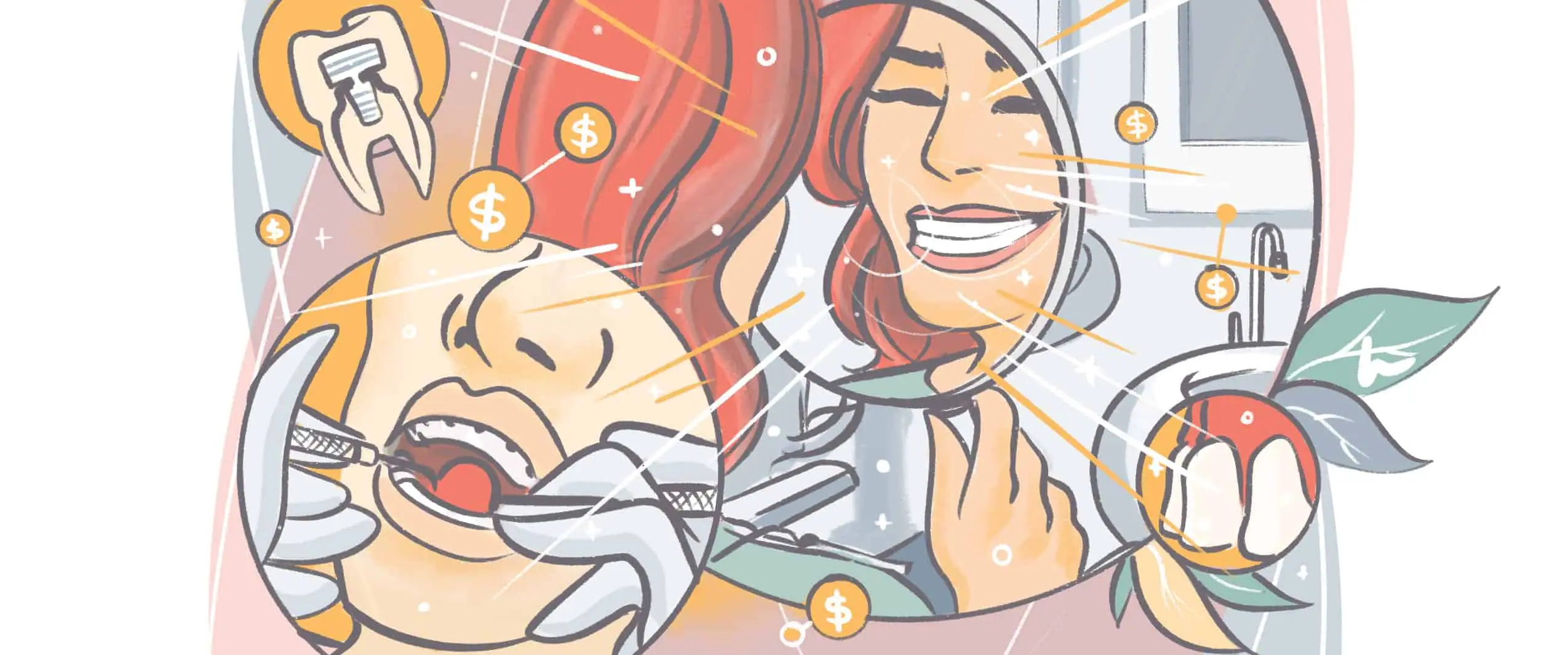Most of us wish our stained teeth would suddenly appear whiter. If you too have found yourself inspecting your smile and wishing your teeth were more pearly than, well, any other color, you’re not alone.
80% of Americans between 18 and 49 wish their teeth were whiter. For women, that same survey reports the numbers are as high as 85%.
We’re going to review some of the main causes of teeth staining and prevention. To help you on your journey to a whiter smile, we’ll also share some tips on how to treat stained teeth.
Due for a checkup?
Find a top rated dentist near you that takes your insurance.
3 Primary Types of Tooth Stains

- Extrinsic Stains: These are your fairly simple, surface-level stains. They’re often caused by certain types of food and drink, tobacco use, or, sometimes, just plain poor oral hygiene habits. The bad news is that extrinsic stains are common. The good news? These stains on the enamel can be dealt with more easily than the other two primary types of tooth stains.
- Intrinsic Stains: These types of stains are trickier to address. Intrinsic stains are more deeply-ingrained below the surface of the teeth in the dentin layer. Wondering why that whitening toothpaste didn’t make a difference on your stained teeth? You might be dealing with intrinsic tooth stains, which can result from trauma, root canal treatment, and fluorosis. More sophisticated methods are needed to counteract these stains.
- Age-Related Stains: To some extent, stained teeth are unavoidable throughout a lifetime. This is because dentin naturally yellows over time. As toothpaste giant Crest notes, enamel also thins as teeth age, allowing yellowing dentin to show through. This doesn’t necessarily mean that older people are doomed to yellow teeth, but they are almost certainly more at risk.
It’s worth noting that it’s rare to just have one type of stained teeth, the different types of stains can work in tandem and compound one another.
How Teeth Get Stained
Teeth can get stained in a variety of ways. Here are some of the most common reasons that your smile can lose its sparkle.
Various Foods
A veritable fridge-worth of food can stained teeth. Here are 10 of the more common offenders:
- Citrus fruits
- Tomatoes
- Sweets
- Popsicles
- Soy sauce
- Curry
- Beets
- Blueberries
- Blackberries
- Pomegranates
You don’t have to avoid all the food above to keep your teeth white. But keeping in mind what types of food can cause stains can be a helpful tool when learning how to prevent future stains.
Drinks
Liquids can be equally damaging to your enamel and lead to stained teeth. Here are some drinks that can lead to tooth discoloration:
- Juices made from any of the foods above
- Soda (which contain dyes and acids that can stain teeth)
- Coffee (which has tannins that can cause discoloration)
- Tea (with tannins that discolor teeth at a higher rate than coffee)
- Alcohol (people experiencing alcohol use disorder tend to have higher plaque levels and are 3x more likely to experience tooth loss)
- Wine (which also has tannins and, as Vox noted, can stain teeth hereditarily)
As with the foods above, all of the drinks here don’t have to be forsaken to preserve teeth. Moderation is key, as are some other strategies we’ll talk about in the next section of this article.
Tobacco Products (Not Just Cigarettes)
Few things can stain teeth like tobacco, though it’s not just cigarettes you need to watch out for. Even electronic cigarettes can cause stains, as can smokeless tobacco.
Thank science for the main reason tobacco, in its various forms, is infamous for staining teeth. When combined with oxygen, nicotine turns yellow. Nicotine and tobacco tar also absorb into the tooth’s natural pores. Even the way a smoker smokes can affect their teeth, with this dental website noting: “Often, smokers will have certain teeth that become darker than others due to their method of inhalation.”
However it happens, brown stains on the back of teeth or brown stains on teeth near gums can be a sign that tobacco is beginning to wreak havoc on the mouth and that it’s time to take action.
Poor Dental Hygiene
Put simply, if you’re not listening to your dentist, you’re likely helping those stains get worse. Brushing, flossing, and using mouthwash all work together to keep your mouth clean and your teeth protected from stains. When you skip these steps, stains can build up quickly.
To avoid these problems, it’s important to see a dentist frequently. If you get regular cleanings at the dentist, you will not only get rid of intrinsic stains, but also prevent issues that can stain teeth down the road.
Feeling motivated now? Good news, because stains begin extrinsically, they can be removed if brushing, flossing, and mouthwash habits improve. If you decide to keep skipping the floss, remember when stains can get down to the intrinsic dentin level, they are far more difficult to eradicate.
Trauma
Blunt trauma, such as from a fall, can cause teeth to become yellow or brown for children and lead to grey or black discoloration for adults.
When tooth trauma occurs in children, only the baby teeth are typically affected and healthy adult teeth grow in eventually. It’s usually just a matter of playing the waiting game to have a fully white smile again—with a pediatric dentist weighing in, of course.
Unlucky Genes

When it comes to stained teeth, some people are just unlucky. More people are predisposed when it comes to tooth discoloration than you might expect.
A Massachusetts-based dental director noted that genetics are the top reason people have discolored teeth, telling Live Science: “Dentinogenesis imperfecta and amelogenesis imperfecta are two inherited disorders that cause the teeth to develop improperly and could lead to discoloration.”
Disease, Pregnancy, and Vitamin Deficiency
Cancer, or chemotherapy more appropriately, can cause tooth discoloration. Pregnant mothers can get infections that affect the enamel development of their children, according to WebMD. In addition, tooth discoloration resulting from vitamin deficiency is something to watch out for.
Medication
Medications can cause stained teeth too, often enough that the National Institute of Health weighed in with a 2014 paper “to give an overview of the various medications that can be linked to tooth discoloration and to suggest the precautionary measures that can be taken to avoid or minimize it.”
Medications known to affect teeth, according to WebMD, include antibiotics, antihistamines, and antipsychotics.
Age
Sometimes teeth will get more yellow as a person ages even if their oral hygiene is top-notch.
A 2010 article published by Harvard University noted that roughly 75 percent of people over the age of 65 still had some or all of their natural teeth. But because of this, this population was more likely to suffer from a variety of oral ailments, including dental decay and stained teeth.
Fluoride
Often a controversial subject, fluoride technically has been reported to cause staining, but not the same kind as sodas or medication.
NBC News noted in 2018 that nearly 75 percent of the United States receives fluoride in its community water supply. The article states, that despite the recent backlash, there are few negative symptoms of adding fluoride to water: “In this country, the only common side effect of fluoridation is fluorosis of the teeth — minor staining that is often only visible to a dentist.”
Treating and Preventing Stained Teeth: At Home
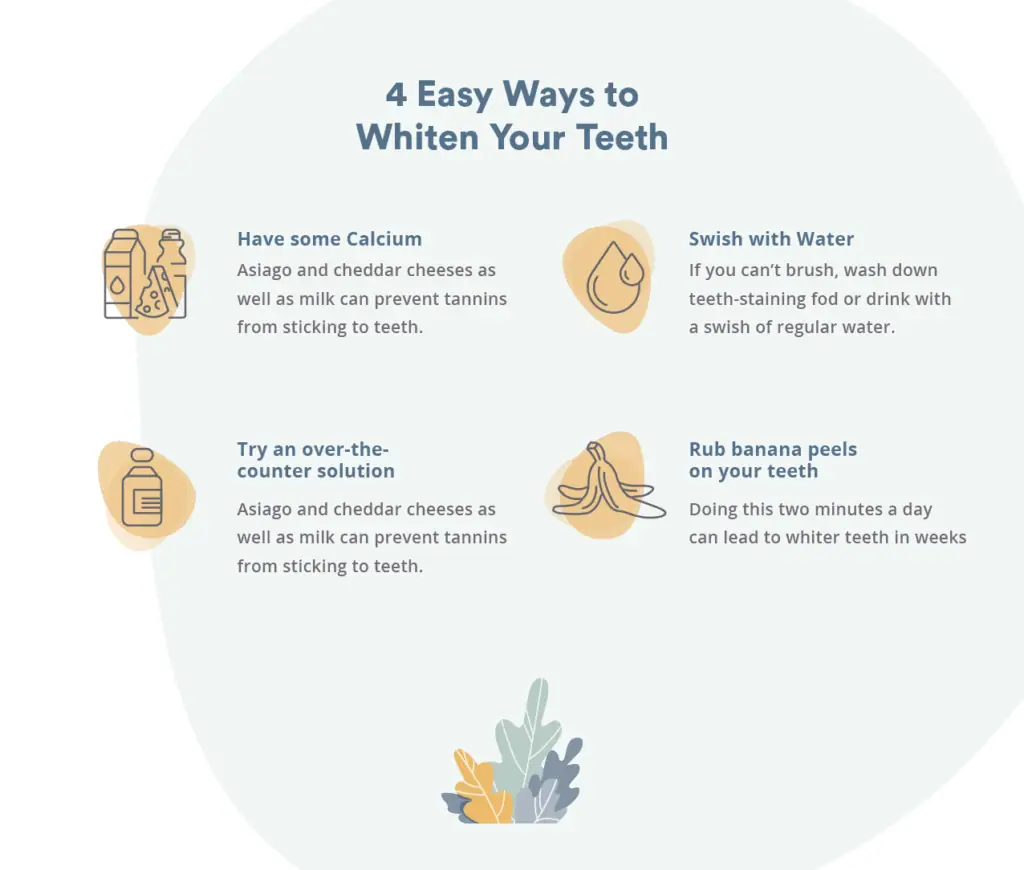
Do you currently have stained teeth? Fear not. The treatment strategies outlined below will help you deal with even the direst of teeth stains. But first — a few tips to help prevent teeth from ever becoming stained, to begin with.
8 Ways to Prevent Coffee and Tea Stains
Coffee and tea can mess up teeth easily (in fact, tea can surprisingly stain teeth at a higher rate than coffee). However, it’s not hard to fight back and reclaim that pearly, white smile we all desire.
Here are eight things that can be done to prevent coffee and tea from staining teeth:
- Wait to brush: Coffee, especially, is acidic. As this article notes: “Brushing your teeth immediately after eating or drinking anything acidic weakens tooth enamel and causes staining.”
- Eat strawberries or lemons: Their natural fibers can break down bacteria from food and drink, including from coffee and tea.
- Drink through a to-go lid or a straw: Doing this can “reduce some of the acid created in your mouth.”
- Rotate your beverages with water: This can ease thirst, while also helping clean the mouth.
- Drink water quickly: Quickly drinking or swishing water can wash away coffee and tea’s tannins and residue from the mouth.
- Drink milk: A study by the School of Dentistry at the University of Alberta found that casein in milk helps prevent teeth staining.
- Chew sugar-free gum: This is another well-known remedy, though this dentist says to make sure to find gums with the American Dental Association’s seal of approval.
- Limit consumption: Those who look into it generally recommend that adults have no more than a few cups of coffee per day. Among the benefits: Healthier teeth.
Create a Barrier that Wards Off Stains
Quesadilla lovers of the world, rejoice!
A Woman’s Day piece, cataloging six ways to keep red wine from staining teeth, noted that cheeses such as asiago and cheddar “coat your teeth in calcium, making it harder for the tannins to stick.”
And, the same piece noted that the petroleum in lip gloss can act as a natural barrier against tannins that stick to teeth.
Whiten with Banana Peels (No, Seriously)
A specialist confirmed that rubbing the insides of banana peels on teeth two minutes a day can yield whiter teeth after just three weeks.
There’s a caveat, though: “If you rub the skin it can act as a gentle exfoliator and will remove some surface stains, but the banana will not reach inside the pores on the surface of your enamel — so no true ‘deep’ cleaning will take place.”
Make a Dent in Nicotine Stains
A variety of remedies, such as brushing after smoking, can keep teeth looking their whitest, though the involvement of professionals might be needed to remove nicotine stains.
Professional whitening
Simple, over-the-counter stained teeth remedies often work best with extrinsic or “surface-level” stains. Medical News Today spells out an assortment of strategies including brushing with a mixture of baking soda and water, rinsing with a diluted hydrogen peroxide solution, and using whitening mouthwashes or toothpaste.
However, those intrinsic, deeper stains often require the attention of dental professionals.
If you want whiter teeth, we can help.
Regular trips to the dentist can help your teeth look their whitest and present future stains.
Book a dental consultation.
Find a dentist near you to tell you more about getting started on this procedure.

